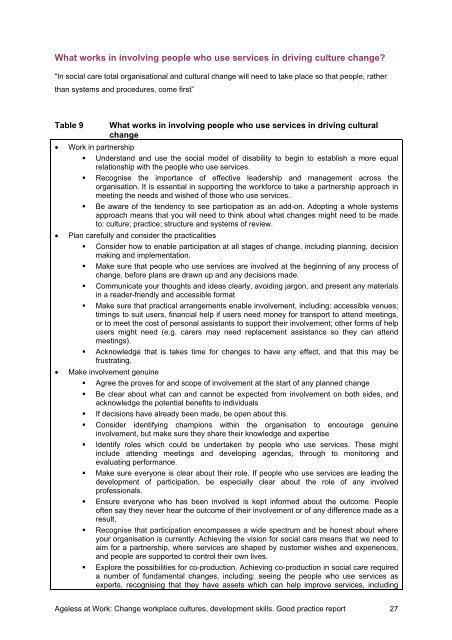Ageless at Work - Skills for Care
Ageless at Work - Skills for Care
Ageless at Work - Skills for Care
You also want an ePaper? Increase the reach of your titles
YUMPU automatically turns print PDFs into web optimized ePapers that Google loves.
Wh<strong>at</strong> works in involving people who use services in driving culture change?<br />
“In social care total organis<strong>at</strong>ional and cultural change will need to take place so th<strong>at</strong> people, r<strong>at</strong>her<br />
than systems and procedures, come first”<br />
Table 9 Wh<strong>at</strong> works in involving people who use services in driving cultural<br />
change<br />
<strong>Work</strong> in partnership<br />
• Understand and use the social model of disability to begin to establish a more equal<br />
rel<strong>at</strong>ionship with the people who use services.<br />
• Recognise the importance of effective leadership and management across the<br />
organis<strong>at</strong>ion. It is essential in supporting the work<strong>for</strong>ce to take a partnership approach in<br />
meeting the needs and wished of those who use services.<br />
• Be aware of the tendency to see particip<strong>at</strong>ion as an add-on. Adopting a whole systems<br />
approach means th<strong>at</strong> you will need to think about wh<strong>at</strong> changes might need to be made<br />
to: culture; practice; structure and systems of review.<br />
Plan carefully and consider the practicalities<br />
• Consider how to enable particip<strong>at</strong>ion <strong>at</strong> all stages of change, including planning, decision<br />
making and implement<strong>at</strong>ion.<br />
• Make sure th<strong>at</strong> people who use services are involved <strong>at</strong> the beginning of any process of<br />
change, be<strong>for</strong>e plans are drawn up and any decisions made.<br />
• Communic<strong>at</strong>e your thoughts and ideas clearly, avoiding jargon, and present any m<strong>at</strong>erials<br />
in a reader-friendly and accessible <strong>for</strong>m<strong>at</strong><br />
• Make sure th<strong>at</strong> practical arrangements enable involvement, including: accessible venues;<br />
timings to suit users, financial help if users need money <strong>for</strong> transport to <strong>at</strong>tend meetings,<br />
or to meet the cost of personal assistants to support their involvement; other <strong>for</strong>ms of help<br />
users might need (e.g. carers may need replacement assistance so they can <strong>at</strong>tend<br />
meetings).<br />
• Acknowledge th<strong>at</strong> is takes time <strong>for</strong> changes to have any effect, and th<strong>at</strong> this may be<br />
frustr<strong>at</strong>ing.<br />
Make involvement genuine<br />
• Agree the proves <strong>for</strong> and scope of involvement <strong>at</strong> the start of any planned change<br />
• Be clear about wh<strong>at</strong> can and cannot be expected from involvement on both sides, and<br />
acknowledge the potential benefits to individuals<br />
• If decisions have already been made, be open about this.<br />
• Consider identifying champions within the organis<strong>at</strong>ion to encourage genuine<br />
involvement, but make sure they share their knowledge and expertise<br />
• Identify roles which could be undertaken by people who use services. These might<br />
include <strong>at</strong>tending meetings and developing agendas, through to monitoring and<br />
evalu<strong>at</strong>ing per<strong>for</strong>mance.<br />
• Make sure everyone is clear about their role. If people who use services are leading the<br />
development of particip<strong>at</strong>ion, be especially clear about the role of any involved<br />
professionals.<br />
• Ensure everyone who has been involved is kept in<strong>for</strong>med about the outcome. People<br />
often say they never hear the outcome of their involvement or of any difference made as a<br />
result.<br />
• Recognise th<strong>at</strong> particip<strong>at</strong>ion encompasses a wide spectrum and be honest about where<br />
your organis<strong>at</strong>ion is currently. Achieving the vision <strong>for</strong> social care means th<strong>at</strong> we need to<br />
aim <strong>for</strong> a partnership, where services are shaped by customer wishes and experiences,<br />
and people are supported to control their own lives.<br />
• Explore the possibilities <strong>for</strong> co-production. Achieving co-production in social care required<br />
a number of fundamental changes, including: seeing the people who use services as<br />
experts, recognising th<strong>at</strong> they have assets which can help improve services, including<br />
<strong>Ageless</strong> <strong>at</strong> <strong>Work</strong>: Change workplace cultures, development skills. Good practice report 27








